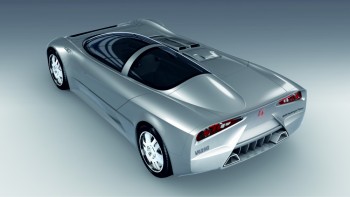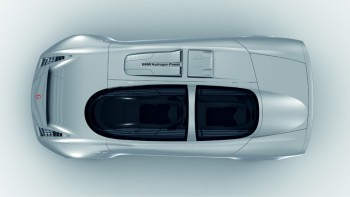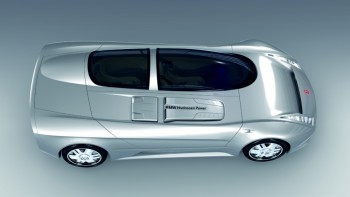|
Once again, the
occasion of the Geneva Motor Show offered the opportunity to
develop research on form and contents that break away from
the industrial approach that Italdesign Giugiaro adopt daily
in order to supply their worldwide clients with designs that
best suit their markets. The challenging “diversion” this
year represented a niche theme meant to be heatedly
discussed: a super-sporty extreme two-seater fuelled by
hydrogen to meet the increasingly pressing need to promote
and develop alternative and environment friendly propulsion
systems and to explore the potential challenge offered to
design by a more flexible “displacement” of the chassis
lay-out in new engine, mechanical, and electronic
equipments.
The decision to remove the steering wheel took Italdesign
Giugiaro to the creation of a highly innovative driving
system: two joysticks are fixed on the armrests of the
pilot’s seating and pedals unit, where all elements can be
adjusted and customized to the driver’s needs. The
armrest/joystick/electrical pedals and seating unit is not
connected to the chassis. This and its by-wire impulses
system allow to adapt the different versions with right,
centre and left driving with no onerous works once the
vehicle should go into production. This system presents
design - construction and performance - characteristics that
prompted Italdesign Giugiaro to patent it.
VAD.HO is meant to be an open “work in progress": it has
been positively welcome by BMW that accepted to provide for
it their series 7 12 cylinders hydrogen powered engine. One
curiosity: the acronym “VAD.HO” is a play on words that uses
the name of the Vadò industrial area in Moncalieri where
Italdesign Giugiaro headquarters have been located since
1974, and also refers to the hydrogen propulsion system
adopted for the vehicle (vado - or “I go" in Italian - on
H).
The cockpit
This model immediately puts all its ambitions on the line: a
longitudinal cockpit in polycarbonate emerges on the
left-hand side while the right side houses the engine and
hydrogen propulsion devices in the centre. The two Argonauts
are seated in tandem in the fuselage, settled into a
comfortable and super-equipped ergonomic cockpit.
The joysticks are fixed in the armrests that are integral
with the pilot seat (the left armrest can be raised to
facilitate getting in and out of the vehicle). Designers and
technicians believe that this solution facilitates naturally
comfortable – and therefore stable and precise – steering
manoeuvres and activation of all the joystick commands,
including driving and secondary devices such as
entertainment and other options. In order to facilitate
manoeuvres in curves without having to twist or rotate your
wrists, the joysticks were conceived with two grips that
help the necessary movements. The joystick moves back and
forth along the armrest to ensure driver comfort, as well as
the sliding pedal block that, hinged on the lower part,
adjusts to the seat, which is in turn fixed to the chassis.
The control group is designed as an IT console with liquid
crystal displays designed for aeronautic applications (EFIS
- Electronic Flight Information Systems). The digital
driving instrumentation is positioned centrally under the
rear-view continual video monitors and the navigator; side
video cameras project films externally. The surface occupied
by the instrumentation is in any case limited, in order to
allow the pilot maximum external visibility. Access to IT
data from the console is also available to the rear
passenger by means of a dedicated joystick, similar to the
driver's, and two monitors built into the back of the
driver's seat. The faces of both pilot and passenger are
filmed by video cameras and may appear on reciprocal
monitors to enhance team interaction. Thanks to video
cameras installed in the frontal optical group, the driver
can use the monitors either for parking radar and for an
infrared effect for night-time driving, or interactive
driving between the car and road infrastructures, when they
become available.
Passengers get
into the vehicle through two integrated doors/domes that are
hinged lengthwise onto the structure and lift gull-wing
style. The living space for the pilot and passenger are
definitely comfortable because they were calculated at an
"OSCAR percentile” larger than 95% and therefore more
spacious than those of a luxury sedan. The rear passenger is
able to stretch out his legs and change his position by
adjusting the footrest platforms on the sides of the front
seat. The armchairs are also equipped with four-point belts
that can be regulated all around. Passenger safety in case
of collision or overturning is guaranteed by structural side
reinforcements, the steel roll bar on which the two
semi-domes rest, and the activation of the air bags in the
oval strip under the structure at the cockpit base. The cell
is equipped with “umbrella” airbags that surround both the
pilot and the passenger.
|
 |
|
The blunt one-piece rear end recalls the Corvette,
but is characterised by the line of the bonnet with
its asymmetric profile because it must converge with
the dipping line of the cockpit and the side/engine
line. |
|
 |
|
 |
|
VAD.HO is meant to be an open “work in progress": it
has been positively welcome by BMW that accepted to
provide for it their series 7 12 cylinders hydrogen
powered engine. |
|
 |
|
 |
|
The decision to remove the steering wheel took
Italdesign Giugiaro to the creation of a highly
innovative driving system: two joysticks are fixed
on the armrests of the pilot’s seating and pedals
unit. |
|
 |
|
|
 |
|
This model immediately puts all its ambitions on the
line: a longitudinal cockpit in polycarbonate
emerges on the left-hand side while the right side
houses the engine and hydrogen propulsion devices in
the centre. |
|
 |
|
 |
|
Naturally, the aerodynamic penetration requirements
are enhanced by the reduction in the main section
because the windscreen/cockpit impacts on only half
of the vehicle. |
|
 |
|
 |
|
The nose presents a screwed-on bumper block with
ample air intakes. The lower zone of the bonnet
features an adjustable spoiler in between the
“pagoda”-shaped ridges formed by the fenders that
smooth off into the sides. |
|
 |
|
|
The upholstery materials chosen for the interior are in
metallic and phosphorescent opaque grey tones: both for the
silver leather armchairs and the synthetic pieces in
aeronautic styling. Bolder effects were used in areas around
the control console.
The package
The sporty-racy ambitions of this project have imposed a
wedgeshaped volume, backed up by very subtle lines and
modulations that are never forced or exasperating, but
rather in perfect harmony with those parameters of balance
and elegance that distinguish the Giugiaro trademark. The
introduction of stylistic features was intentionally avoided
on this project, which is undoubtedly oriented towards
contents. In fact, the VAD.HO body is characterised by a
feasible decomposition with regards to production logics and
meets international homologation regulations (including
pedestrian accidents).
Even the overall dimensions are “reasonable”. The figures
are close to those of the Ferrari Maranello, a compact
two-seater with similar performances: 4550 mm long, 1980 mm
wide, and 1150 mm high, like Enzo model. Naturally, the
aerodynamic penetration requirements are enhanced by the
reduction in the main section because the windscreen/cockpit
impacts on only half of the vehicle. The nose presents a
screwed-on bumper block with ample air intakes. The lower
zone of the bonnet features an adjustable spoiler in between
the “pagoda”-shaped ridges formed by the fenders that smooth
off into the sides. The optical devices are housed in a
drop-shaped recess that begins
with the bumpers and narrows towards the sides: this cavity
houses the dual-function projector, the position and
direction LEDs, a video camera at the top, and the passenger
compartment air intake.
The asymmetric transparent dome gives this car a strong
personality; the windscreen wiper is hidden under the small
cowl. From the side, the profile of the fender crest is
sinuous and dips towards the centre, while a bird’s eye view
confirms the designer’s will to make the front more
aggressive and modulated and the tail softer and sharper.
The originality of the cockpit's asymmetric solution is even
more visible in VAD.HO central body. The fairing of the
engine air system, the filter, and the electronics can be
seen on lowered section that houses the engine. Since the
cut of the passenger door is repeated symmetrically on the
engine side, the engine block can be simply accessed by
raising the large panel/trapezoidal door hinged onto the
centre line with a gull-wing movement. The recess of the
side indicator also serves as housing for the video camera.
The blunt one-piece rear end recalls the Corvette, but is
characterised by the line of the bonnet with its asymmetric
profile because it must converge with the dipping line of
the cockpit and the side/engine line. The trunk capacity for
a super-sporty two-seater is truly remarkable: 550 dm3. The
rear end view is “carved” to emphasize all the
aggressiveness of this vehicle’s nature. The “G” Giugiaro
logo was adopted to house the rear stop LEDs with striking
media impact.
VAD.HO is following up the content research started by
Italdesign Giugiaro with 2004 Toyota Alessandro Volta with
hybrid propulsion and the 2005 Mitsubishi Nessie that runs
on hydrogen; while the formal aspects evoke the design of
the 1988 Aztec, which even then offered driver and passenger
a chance to slide into a definitely attractive “aeronautic”
atmosphere with a formula that today is much more easily
feasible thanks to IT innovations and by wire technologies
that have been tested and nowadays are considered to be
reliable. This evocation of the world of aeronautics is
shown again in the colours choice for the body - opaque
silver-grey -, in the service decals on the engine equipment
and the fuel tank, and the use of large 20" solid tyres.
Italdesign
Giugiaro - VAD.HO, Technical Specifications: Length 4550
mm; Width 1980 mm; Height 1150 mm; Wheelbase 2800 mm; Front
track 1700 mm; Rear track 1660 mm; Front overhang 947 mm;
Rear overhang 797 mm; Weight 1150 Kg; Engine BMW 12
cylinders – fuel: hydrogen; Gearbox BMW Smg drivelogic, 7
speed; Drivetrain rear; Suspension front and rear:
independent double wishbone - coaxial, springs and hydraulic
shock absorber - anti roll bar - anti dive and anti squat
devices; Brakes Brembo: Front Ventilated disc ø 380x34mm
caliper: 8 pistons, Rear Ventilated disc ø 355x32 mm,
Caliper: 4 pistons; Tires Vredestein: Front 275/35x20, Rear
315/35x20, Rims OZ Front 10” x 20”, Rear 11” x 20”
|
|
|
|